1803ICT/7610ICT: G-Train Human Activity System and IS Analysis Report
VerifiedAdded on 2022/12/05
|15
|5638
|106
Report
AI Summary
This report analyzes the G-Train's existing Human Activity System (HAS) to identify issues and propose a new information system (IS) to enhance performance. The report begins with an executive summary and introduction, followed by a complete business analysis of the G-Train, including its strategies, operations, and market competition. It employs Mintzberg's classification to describe the organizational structure and Porter's Value Chain Model to analyze primary and secondary activities. The report also uses Porter's Five Forces model to assess the competitive landscape. The second part focuses on analyzing an existing HAS within the G-Train, identifying problems, and suggesting an IS solution to address these issues. Keywords like HAS, Information System, and G: Link are highlighted throughout the report. The report is a comprehensive analysis of the G-Train's business operations and suggests improvements through the implementation of an IS.
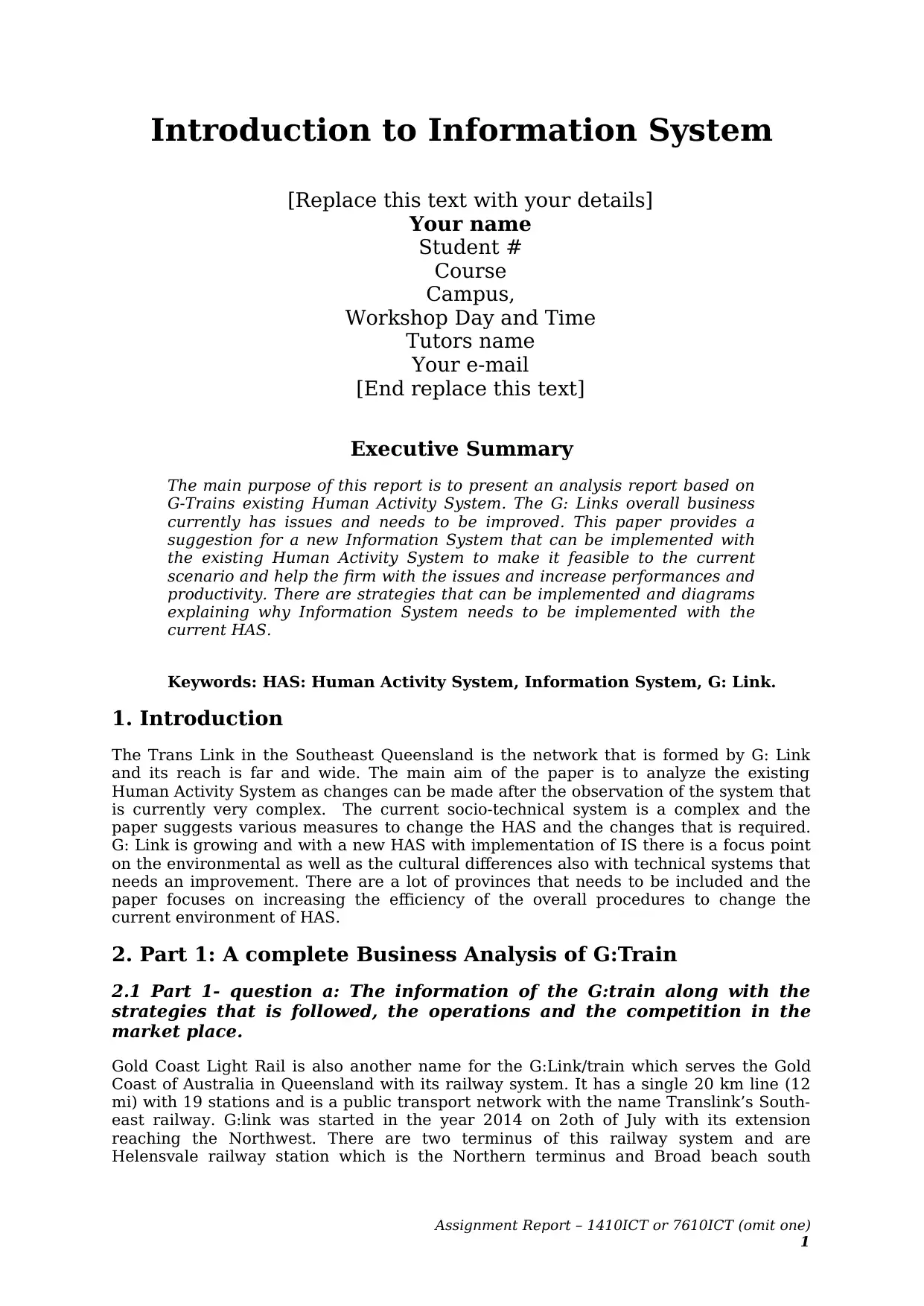
Introduction to Information System
[Replace this text with your details]
Your name
Student #
Course
Campus,
Workshop Day and Time
Tutors name
Your e-mail
[End replace this text]
Executive Summary
The main purpose of this report is to present an analysis report based on
G-Trains existing Human Activity System. The G: Links overall business
currently has issues and needs to be improved. This paper provides a
suggestion for a new Information System that can be implemented with
the existing Human Activity System to make it feasible to the current
scenario and help the firm with the issues and increase performances and
productivity. There are strategies that can be implemented and diagrams
explaining why Information System needs to be implemented with the
current HAS.
Keywords: HAS: Human Activity System, Information System, G: Link.
1. Introduction
The Trans Link in the Southeast Queensland is the network that is formed by G: Link
and its reach is far and wide. The main aim of the paper is to analyze the existing
Human Activity System as changes can be made after the observation of the system that
is currently very complex. The current socio-technical system is a complex and the
paper suggests various measures to change the HAS and the changes that is required.
G: Link is growing and with a new HAS with implementation of IS there is a focus point
on the environmental as well as the cultural differences also with technical systems that
needs an improvement. There are a lot of provinces that needs to be included and the
paper focuses on increasing the efficiency of the overall procedures to change the
current environment of HAS.
2. Part 1: A complete Business Analysis of G:Train
2.1 Part 1- question a: The information of the G:train along with the
strategies that is followed, the operations and the competition in the
market place.
Gold Coast Light Rail is also another name for the G:Link/train which serves the Gold
Coast of Australia in Queensland with its railway system. It has a single 20 km line (12
mi) with 19 stations and is a public transport network with the name Translink’s South-
east railway. G:link was started in the year 2014 on 2oth of July with its extension
reaching the Northwest. There are two terminus of this railway system and are
Helensvale railway station which is the Northern terminus and Broad beach south
Assignment Report – 1410ICT or 7610ICT (omit one)
1
[Replace this text with your details]
Your name
Student #
Course
Campus,
Workshop Day and Time
Tutors name
Your e-mail
[End replace this text]
Executive Summary
The main purpose of this report is to present an analysis report based on
G-Trains existing Human Activity System. The G: Links overall business
currently has issues and needs to be improved. This paper provides a
suggestion for a new Information System that can be implemented with
the existing Human Activity System to make it feasible to the current
scenario and help the firm with the issues and increase performances and
productivity. There are strategies that can be implemented and diagrams
explaining why Information System needs to be implemented with the
current HAS.
Keywords: HAS: Human Activity System, Information System, G: Link.
1. Introduction
The Trans Link in the Southeast Queensland is the network that is formed by G: Link
and its reach is far and wide. The main aim of the paper is to analyze the existing
Human Activity System as changes can be made after the observation of the system that
is currently very complex. The current socio-technical system is a complex and the
paper suggests various measures to change the HAS and the changes that is required.
G: Link is growing and with a new HAS with implementation of IS there is a focus point
on the environmental as well as the cultural differences also with technical systems that
needs an improvement. There are a lot of provinces that needs to be included and the
paper focuses on increasing the efficiency of the overall procedures to change the
current environment of HAS.
2. Part 1: A complete Business Analysis of G:Train
2.1 Part 1- question a: The information of the G:train along with the
strategies that is followed, the operations and the competition in the
market place.
Gold Coast Light Rail is also another name for the G:Link/train which serves the Gold
Coast of Australia in Queensland with its railway system. It has a single 20 km line (12
mi) with 19 stations and is a public transport network with the name Translink’s South-
east railway. G:link was started in the year 2014 on 2oth of July with its extension
reaching the Northwest. There are two terminus of this railway system and are
Helensvale railway station which is the Northern terminus and Broad beach south
Assignment Report – 1410ICT or 7610ICT (omit one)
1
Paraphrase This Document
Need a fresh take? Get an instant paraphrase of this document with our AI Paraphraser
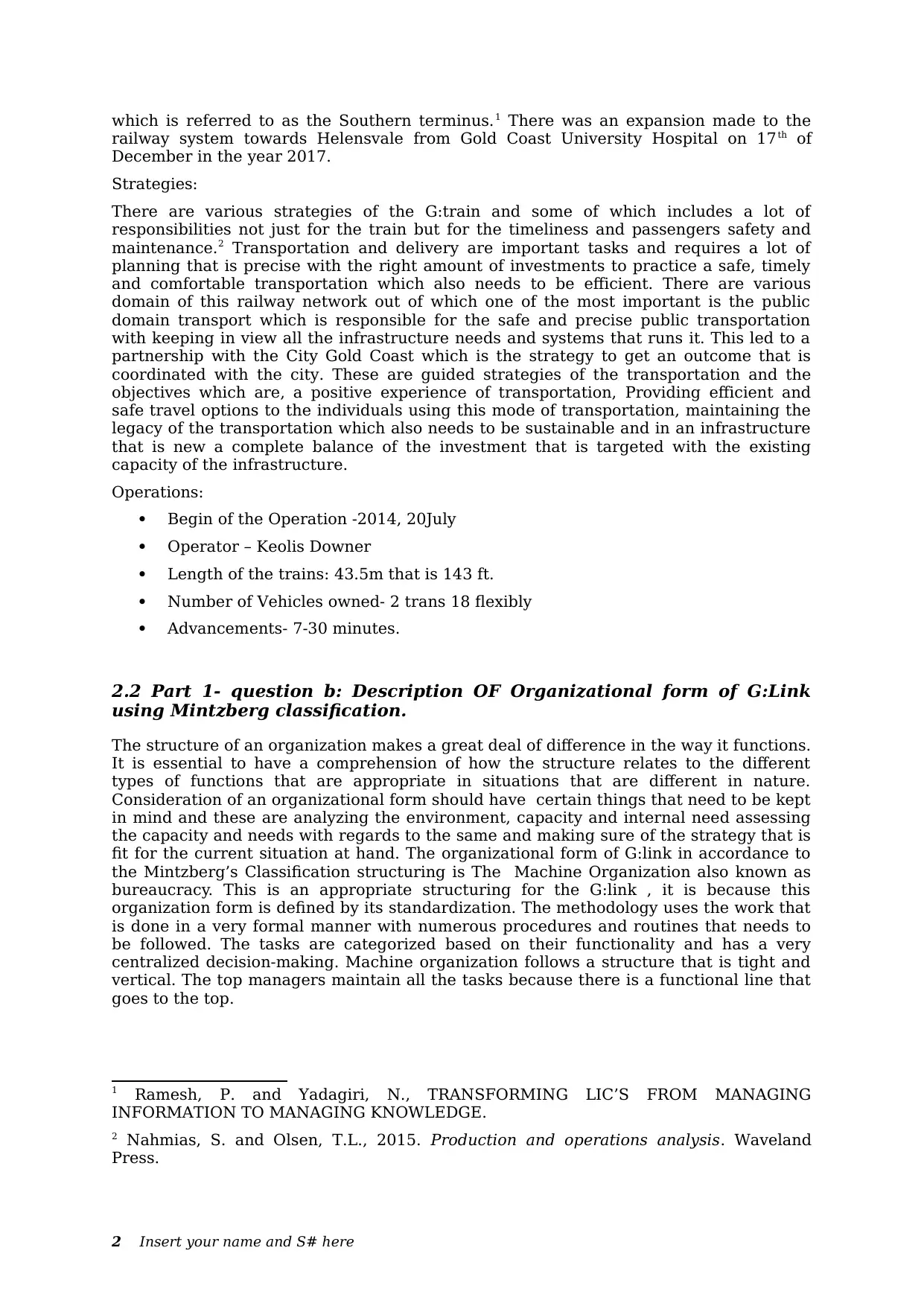
which is referred to as the Southern terminus.1 There was an expansion made to the
railway system towards Helensvale from Gold Coast University Hospital on 17th of
December in the year 2017.
Strategies:
There are various strategies of the G:train and some of which includes a lot of
responsibilities not just for the train but for the timeliness and passengers safety and
maintenance.2 Transportation and delivery are important tasks and requires a lot of
planning that is precise with the right amount of investments to practice a safe, timely
and comfortable transportation which also needs to be efficient. There are various
domain of this railway network out of which one of the most important is the public
domain transport which is responsible for the safe and precise public transportation
with keeping in view all the infrastructure needs and systems that runs it. This led to a
partnership with the City Gold Coast which is the strategy to get an outcome that is
coordinated with the city. These are guided strategies of the transportation and the
objectives which are, a positive experience of transportation, Providing efficient and
safe travel options to the individuals using this mode of transportation, maintaining the
legacy of the transportation which also needs to be sustainable and in an infrastructure
that is new a complete balance of the investment that is targeted with the existing
capacity of the infrastructure.
Operations:
Begin of the Operation -2014, 20July
Operator – Keolis Downer
Length of the trains: 43.5m that is 143 ft.
Number of Vehicles owned- 2 trans 18 flexibly
Advancements- 7-30 minutes.
2.2 Part 1- question b: Description OF Organizational form of G:Link
using Mintzberg classification.
The structure of an organization makes a great deal of difference in the way it functions.
It is essential to have a comprehension of how the structure relates to the different
types of functions that are appropriate in situations that are different in nature.
Consideration of an organizational form should have certain things that need to be kept
in mind and these are analyzing the environment, capacity and internal need assessing
the capacity and needs with regards to the same and making sure of the strategy that is
fit for the current situation at hand. The organizational form of G:link in accordance to
the Mintzberg’s Classification structuring is The Machine Organization also known as
bureaucracy. This is an appropriate structuring for the G:link , it is because this
organization form is defined by its standardization. The methodology uses the work that
is done in a very formal manner with numerous procedures and routines that needs to
be followed. The tasks are categorized based on their functionality and has a very
centralized decision-making. Machine organization follows a structure that is tight and
vertical. The top managers maintain all the tasks because there is a functional line that
goes to the top.
1 Ramesh, P. and Yadagiri, N., TRANSFORMING LIC’S FROM MANAGING
INFORMATION TO MANAGING KNOWLEDGE.
2 Nahmias, S. and Olsen, T.L., 2015. Production and operations analysis. Waveland
Press.
2 Insert your name and S# here
railway system towards Helensvale from Gold Coast University Hospital on 17th of
December in the year 2017.
Strategies:
There are various strategies of the G:train and some of which includes a lot of
responsibilities not just for the train but for the timeliness and passengers safety and
maintenance.2 Transportation and delivery are important tasks and requires a lot of
planning that is precise with the right amount of investments to practice a safe, timely
and comfortable transportation which also needs to be efficient. There are various
domain of this railway network out of which one of the most important is the public
domain transport which is responsible for the safe and precise public transportation
with keeping in view all the infrastructure needs and systems that runs it. This led to a
partnership with the City Gold Coast which is the strategy to get an outcome that is
coordinated with the city. These are guided strategies of the transportation and the
objectives which are, a positive experience of transportation, Providing efficient and
safe travel options to the individuals using this mode of transportation, maintaining the
legacy of the transportation which also needs to be sustainable and in an infrastructure
that is new a complete balance of the investment that is targeted with the existing
capacity of the infrastructure.
Operations:
Begin of the Operation -2014, 20July
Operator – Keolis Downer
Length of the trains: 43.5m that is 143 ft.
Number of Vehicles owned- 2 trans 18 flexibly
Advancements- 7-30 minutes.
2.2 Part 1- question b: Description OF Organizational form of G:Link
using Mintzberg classification.
The structure of an organization makes a great deal of difference in the way it functions.
It is essential to have a comprehension of how the structure relates to the different
types of functions that are appropriate in situations that are different in nature.
Consideration of an organizational form should have certain things that need to be kept
in mind and these are analyzing the environment, capacity and internal need assessing
the capacity and needs with regards to the same and making sure of the strategy that is
fit for the current situation at hand. The organizational form of G:link in accordance to
the Mintzberg’s Classification structuring is The Machine Organization also known as
bureaucracy. This is an appropriate structuring for the G:link , it is because this
organization form is defined by its standardization. The methodology uses the work that
is done in a very formal manner with numerous procedures and routines that needs to
be followed. The tasks are categorized based on their functionality and has a very
centralized decision-making. Machine organization follows a structure that is tight and
vertical. The top managers maintain all the tasks because there is a functional line that
goes to the top.
1 Ramesh, P. and Yadagiri, N., TRANSFORMING LIC’S FROM MANAGING
INFORMATION TO MANAGING KNOWLEDGE.
2 Nahmias, S. and Olsen, T.L., 2015. Production and operations analysis. Waveland
Press.
2 Insert your name and S# here
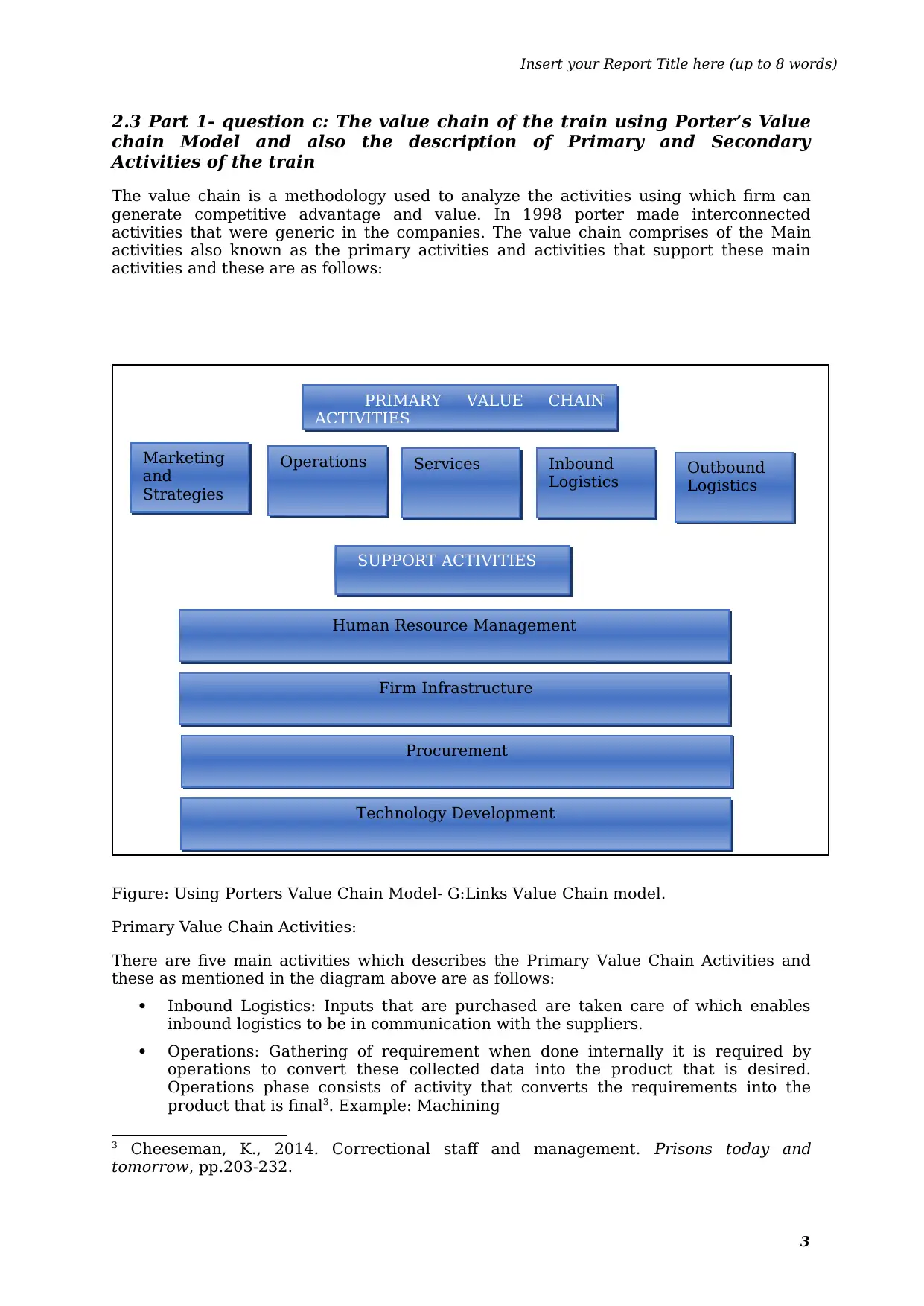
Insert your Report Title here (up to 8 words)
2.3 Part 1- question c: The value chain of the train using Porter’s Value
chain Model and also the description of Primary and Secondary
Activities of the train
The value chain is a methodology used to analyze the activities using which firm can
generate competitive advantage and value. In 1998 porter made interconnected
activities that were generic in the companies. The value chain comprises of the Main
activities also known as the primary activities and activities that support these main
activities and these are as follows:
Figure: Using Porters Value Chain Model- G:Links Value Chain model.
Primary Value Chain Activities:
There are five main activities which describes the Primary Value Chain Activities and
these as mentioned in the diagram above are as follows:
Inbound Logistics: Inputs that are purchased are taken care of which enables
inbound logistics to be in communication with the suppliers.
Operations: Gathering of requirement when done internally it is required by
operations to convert these collected data into the product that is desired.
Operations phase consists of activity that converts the requirements into the
product that is final3. Example: Machining
3 Cheeseman, K., 2014. Correctional staff and management. Prisons today and
tomorrow, pp.203-232.
3
PRIMARY VALUE CHAIN
ACTIVITIES
Marketing
and
Strategies
Operations Services Inbound
Logistics Outbound
Logistics
SUPPORT ACTIVITIES
Human Resource Management
Firm Infrastructure
Procurement
Technology Development
2.3 Part 1- question c: The value chain of the train using Porter’s Value
chain Model and also the description of Primary and Secondary
Activities of the train
The value chain is a methodology used to analyze the activities using which firm can
generate competitive advantage and value. In 1998 porter made interconnected
activities that were generic in the companies. The value chain comprises of the Main
activities also known as the primary activities and activities that support these main
activities and these are as follows:
Figure: Using Porters Value Chain Model- G:Links Value Chain model.
Primary Value Chain Activities:
There are five main activities which describes the Primary Value Chain Activities and
these as mentioned in the diagram above are as follows:
Inbound Logistics: Inputs that are purchased are taken care of which enables
inbound logistics to be in communication with the suppliers.
Operations: Gathering of requirement when done internally it is required by
operations to convert these collected data into the product that is desired.
Operations phase consists of activity that converts the requirements into the
product that is final3. Example: Machining
3 Cheeseman, K., 2014. Correctional staff and management. Prisons today and
tomorrow, pp.203-232.
3
PRIMARY VALUE CHAIN
ACTIVITIES
Marketing
and
Strategies
Operations Services Inbound
Logistics Outbound
Logistics
SUPPORT ACTIVITIES
Human Resource Management
Firm Infrastructure
Procurement
Technology Development
⊘ This is a preview!⊘
Do you want full access?
Subscribe today to unlock all pages.

Trusted by 1+ million students worldwide
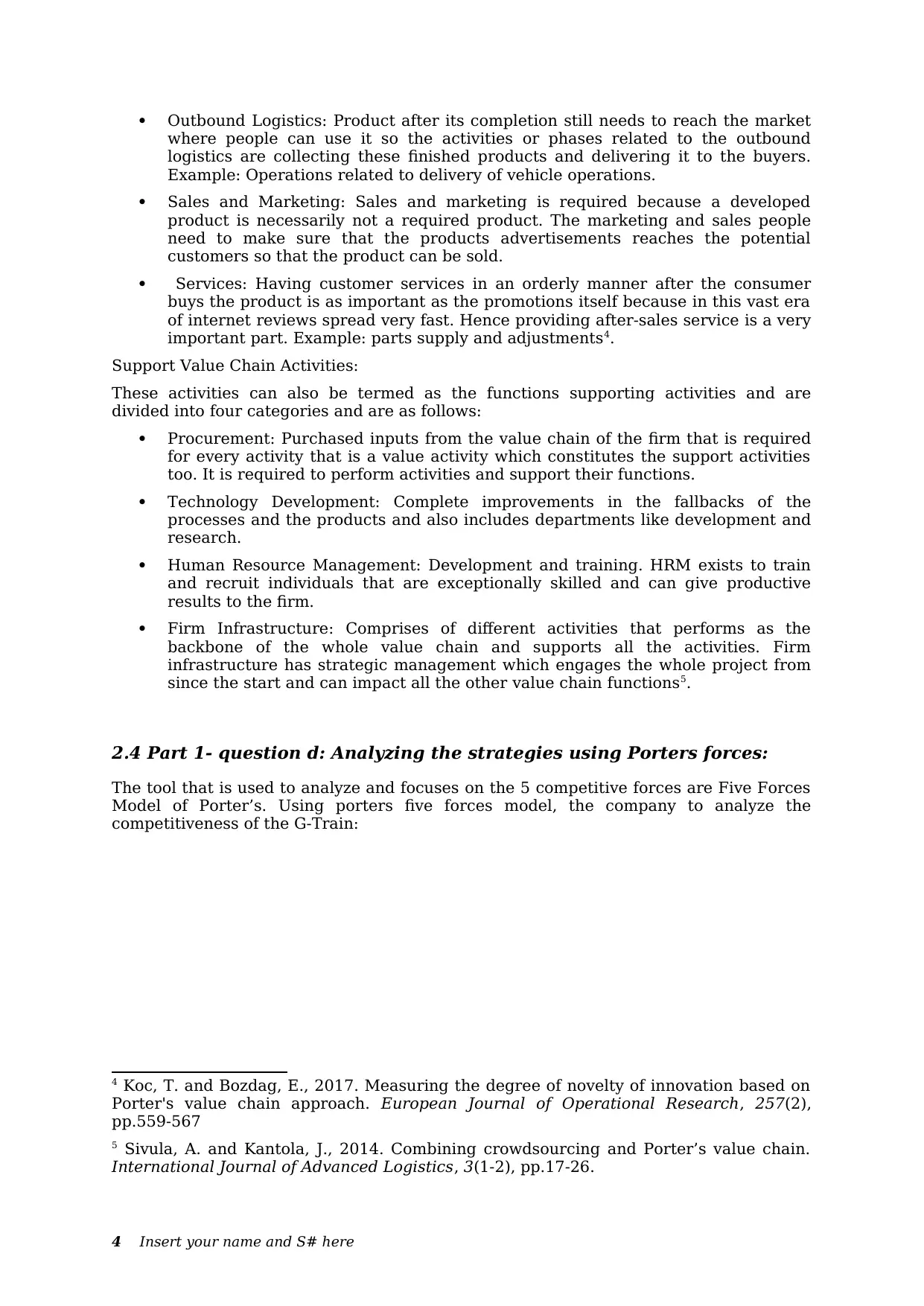
Outbound Logistics: Product after its completion still needs to reach the market
where people can use it so the activities or phases related to the outbound
logistics are collecting these finished products and delivering it to the buyers.
Example: Operations related to delivery of vehicle operations.
Sales and Marketing: Sales and marketing is required because a developed
product is necessarily not a required product. The marketing and sales people
need to make sure that the products advertisements reaches the potential
customers so that the product can be sold.
Services: Having customer services in an orderly manner after the consumer
buys the product is as important as the promotions itself because in this vast era
of internet reviews spread very fast. Hence providing after-sales service is a very
important part. Example: parts supply and adjustments4.
Support Value Chain Activities:
These activities can also be termed as the functions supporting activities and are
divided into four categories and are as follows:
Procurement: Purchased inputs from the value chain of the firm that is required
for every activity that is a value activity which constitutes the support activities
too. It is required to perform activities and support their functions.
Technology Development: Complete improvements in the fallbacks of the
processes and the products and also includes departments like development and
research.
Human Resource Management: Development and training. HRM exists to train
and recruit individuals that are exceptionally skilled and can give productive
results to the firm.
Firm Infrastructure: Comprises of different activities that performs as the
backbone of the whole value chain and supports all the activities. Firm
infrastructure has strategic management which engages the whole project from
since the start and can impact all the other value chain functions5.
2.4 Part 1- question d: Analyzing the strategies using Porters forces:
The tool that is used to analyze and focuses on the 5 competitive forces are Five Forces
Model of Porter’s. Using porters five forces model, the company to analyze the
competitiveness of the G-Train:
4 Koc, T. and Bozdag, E., 2017. Measuring the degree of novelty of innovation based on
Porter's value chain approach. European Journal of Operational Research, 257(2),
pp.559-567
5 Sivula, A. and Kantola, J., 2014. Combining crowdsourcing and Porter’s value chain.
International Journal of Advanced Logistics, 3(1-2), pp.17-26.
4 Insert your name and S# here
where people can use it so the activities or phases related to the outbound
logistics are collecting these finished products and delivering it to the buyers.
Example: Operations related to delivery of vehicle operations.
Sales and Marketing: Sales and marketing is required because a developed
product is necessarily not a required product. The marketing and sales people
need to make sure that the products advertisements reaches the potential
customers so that the product can be sold.
Services: Having customer services in an orderly manner after the consumer
buys the product is as important as the promotions itself because in this vast era
of internet reviews spread very fast. Hence providing after-sales service is a very
important part. Example: parts supply and adjustments4.
Support Value Chain Activities:
These activities can also be termed as the functions supporting activities and are
divided into four categories and are as follows:
Procurement: Purchased inputs from the value chain of the firm that is required
for every activity that is a value activity which constitutes the support activities
too. It is required to perform activities and support their functions.
Technology Development: Complete improvements in the fallbacks of the
processes and the products and also includes departments like development and
research.
Human Resource Management: Development and training. HRM exists to train
and recruit individuals that are exceptionally skilled and can give productive
results to the firm.
Firm Infrastructure: Comprises of different activities that performs as the
backbone of the whole value chain and supports all the activities. Firm
infrastructure has strategic management which engages the whole project from
since the start and can impact all the other value chain functions5.
2.4 Part 1- question d: Analyzing the strategies using Porters forces:
The tool that is used to analyze and focuses on the 5 competitive forces are Five Forces
Model of Porter’s. Using porters five forces model, the company to analyze the
competitiveness of the G-Train:
4 Koc, T. and Bozdag, E., 2017. Measuring the degree of novelty of innovation based on
Porter's value chain approach. European Journal of Operational Research, 257(2),
pp.559-567
5 Sivula, A. and Kantola, J., 2014. Combining crowdsourcing and Porter’s value chain.
International Journal of Advanced Logistics, 3(1-2), pp.17-26.
4 Insert your name and S# here
Paraphrase This Document
Need a fresh take? Get an instant paraphrase of this document with our AI Paraphraser
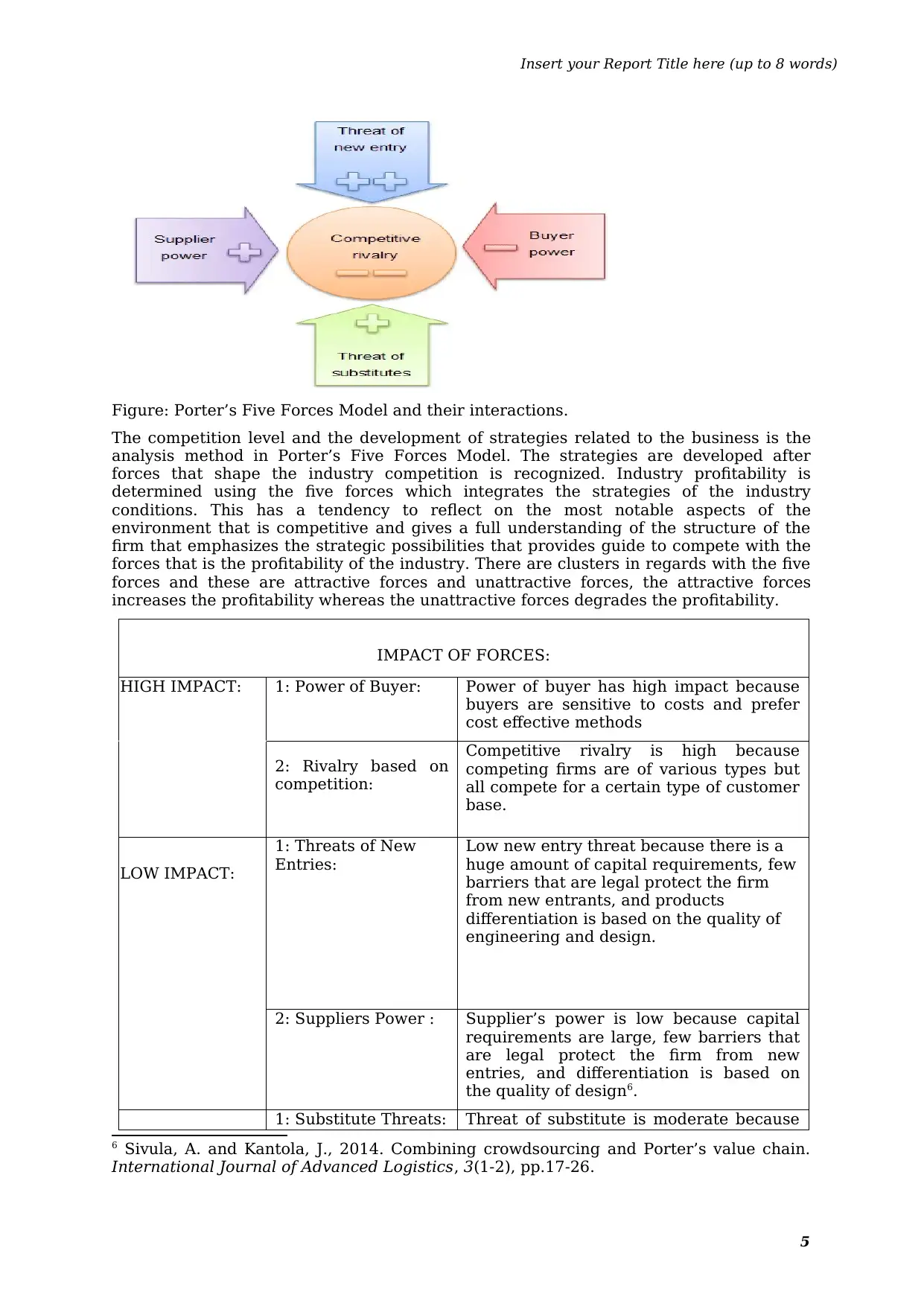
Insert your Report Title here (up to 8 words)
Figure: Porter’s Five Forces Model and their interactions.
The competition level and the development of strategies related to the business is the
analysis method in Porter’s Five Forces Model. The strategies are developed after
forces that shape the industry competition is recognized. Industry profitability is
determined using the five forces which integrates the strategies of the industry
conditions. This has a tendency to reflect on the most notable aspects of the
environment that is competitive and gives a full understanding of the structure of the
firm that emphasizes the strategic possibilities that provides guide to compete with the
forces that is the profitability of the industry. There are clusters in regards with the five
forces and these are attractive forces and unattractive forces, the attractive forces
increases the profitability whereas the unattractive forces degrades the profitability.
IMPACT OF FORCES:
HIGH IMPACT: 1: Power of Buyer: Power of buyer has high impact because
buyers are sensitive to costs and prefer
cost effective methods
2: Rivalry based on
competition:
Competitive rivalry is high because
competing firms are of various types but
all compete for a certain type of customer
base.
LOW IMPACT:
1: Threats of New
Entries:
Low new entry threat because there is a
huge amount of capital requirements, few
barriers that are legal protect the firm
from new entrants, and products
differentiation is based on the quality of
engineering and design.
2: Suppliers Power : Supplier’s power is low because capital
requirements are large, few barriers that
are legal protect the firm from new
entries, and differentiation is based on
the quality of design6.
1: Substitute Threats: Threat of substitute is moderate because
6 Sivula, A. and Kantola, J., 2014. Combining crowdsourcing and Porter’s value chain.
International Journal of Advanced Logistics, 3(1-2), pp.17-26.
5
Figure: Porter’s Five Forces Model and their interactions.
The competition level and the development of strategies related to the business is the
analysis method in Porter’s Five Forces Model. The strategies are developed after
forces that shape the industry competition is recognized. Industry profitability is
determined using the five forces which integrates the strategies of the industry
conditions. This has a tendency to reflect on the most notable aspects of the
environment that is competitive and gives a full understanding of the structure of the
firm that emphasizes the strategic possibilities that provides guide to compete with the
forces that is the profitability of the industry. There are clusters in regards with the five
forces and these are attractive forces and unattractive forces, the attractive forces
increases the profitability whereas the unattractive forces degrades the profitability.
IMPACT OF FORCES:
HIGH IMPACT: 1: Power of Buyer: Power of buyer has high impact because
buyers are sensitive to costs and prefer
cost effective methods
2: Rivalry based on
competition:
Competitive rivalry is high because
competing firms are of various types but
all compete for a certain type of customer
base.
LOW IMPACT:
1: Threats of New
Entries:
Low new entry threat because there is a
huge amount of capital requirements, few
barriers that are legal protect the firm
from new entrants, and products
differentiation is based on the quality of
engineering and design.
2: Suppliers Power : Supplier’s power is low because capital
requirements are large, few barriers that
are legal protect the firm from new
entries, and differentiation is based on
the quality of design6.
1: Substitute Threats: Threat of substitute is moderate because
6 Sivula, A. and Kantola, J., 2014. Combining crowdsourcing and Porter’s value chain.
International Journal of Advanced Logistics, 3(1-2), pp.17-26.
5
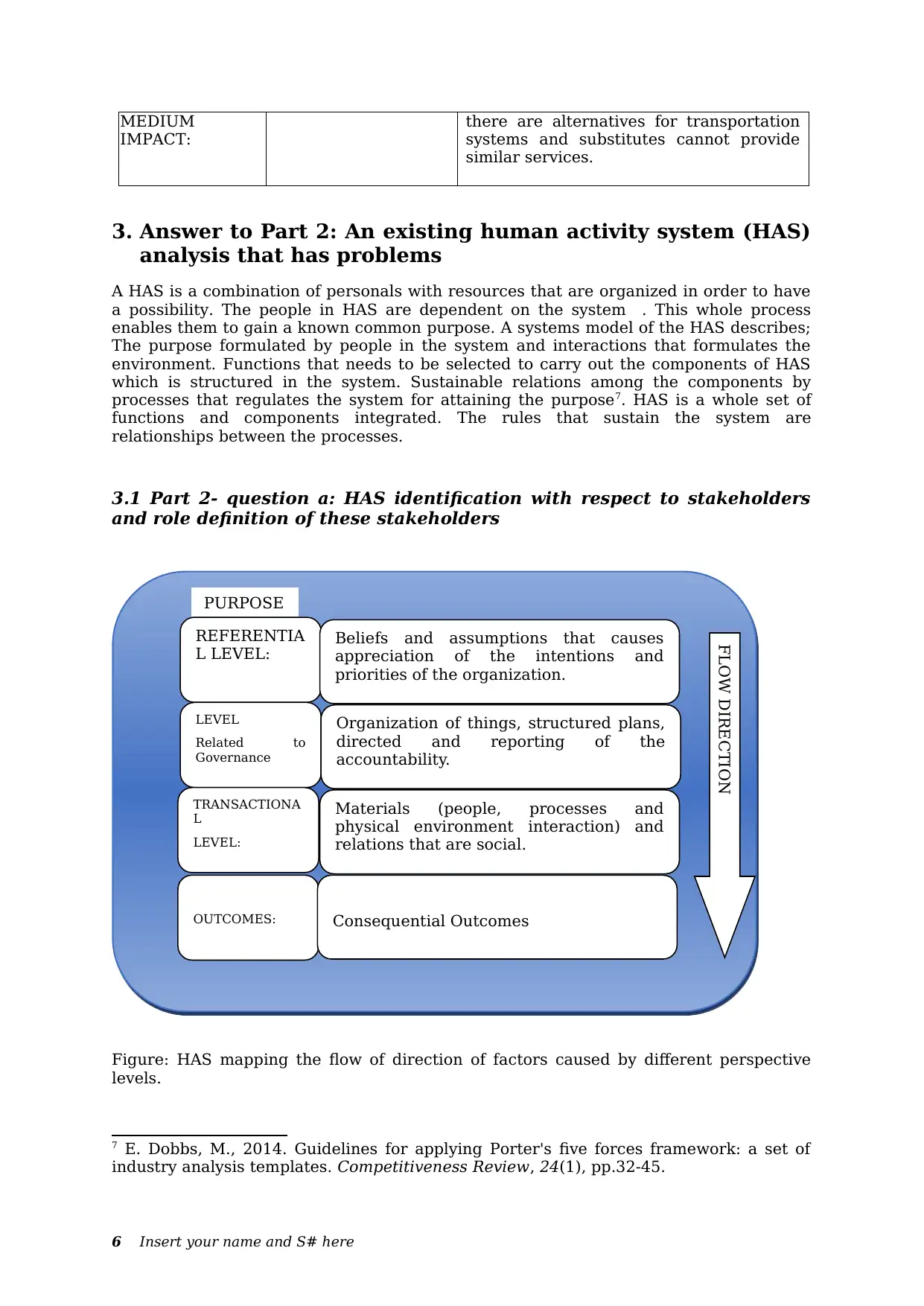
MEDIUM
IMPACT:
there are alternatives for transportation
systems and substitutes cannot provide
similar services.
3. Answer to Part 2: An existing human activity system (HAS)
analysis that has problems
A HAS is a combination of personals with resources that are organized in order to have
a possibility. The people in HAS are dependent on the system . This whole process
enables them to gain a known common purpose. A systems model of the HAS describes;
The purpose formulated by people in the system and interactions that formulates the
environment. Functions that needs to be selected to carry out the components of HAS
which is structured in the system. Sustainable relations among the components by
processes that regulates the system for attaining the purpose7. HAS is a whole set of
functions and components integrated. The rules that sustain the system are
relationships between the processes.
3.1 Part 2- question a: HAS identification with respect to stakeholders
and role definition of these stakeholders
Figure: HAS mapping the flow of direction of factors caused by different perspective
levels.
7 E. Dobbs, M., 2014. Guidelines for applying Porter's five forces framework: a set of
industry analysis templates. Competitiveness Review, 24(1), pp.32-45.
6 Insert your name and S# here
REFERENTIA
L LEVEL:
Beliefs and assumptions that causes
appreciation of the intentions and
priorities of the organization.
LEVEL
Related to
Governance
Organization of things, structured plans,
directed and reporting of the
accountability.
TRANSACTIONA
L
LEVEL:
Materials (people, processes and
physical environment interaction) and
relations that are social.
OUTCOMES: Consequential Outcomes
FLOW DIRECTION
PURPOSE
IMPACT:
there are alternatives for transportation
systems and substitutes cannot provide
similar services.
3. Answer to Part 2: An existing human activity system (HAS)
analysis that has problems
A HAS is a combination of personals with resources that are organized in order to have
a possibility. The people in HAS are dependent on the system . This whole process
enables them to gain a known common purpose. A systems model of the HAS describes;
The purpose formulated by people in the system and interactions that formulates the
environment. Functions that needs to be selected to carry out the components of HAS
which is structured in the system. Sustainable relations among the components by
processes that regulates the system for attaining the purpose7. HAS is a whole set of
functions and components integrated. The rules that sustain the system are
relationships between the processes.
3.1 Part 2- question a: HAS identification with respect to stakeholders
and role definition of these stakeholders
Figure: HAS mapping the flow of direction of factors caused by different perspective
levels.
7 E. Dobbs, M., 2014. Guidelines for applying Porter's five forces framework: a set of
industry analysis templates. Competitiveness Review, 24(1), pp.32-45.
6 Insert your name and S# here
REFERENTIA
L LEVEL:
Beliefs and assumptions that causes
appreciation of the intentions and
priorities of the organization.
LEVEL
Related to
Governance
Organization of things, structured plans,
directed and reporting of the
accountability.
TRANSACTIONA
L
LEVEL:
Materials (people, processes and
physical environment interaction) and
relations that are social.
OUTCOMES: Consequential Outcomes
FLOW DIRECTION
PURPOSE
⊘ This is a preview!⊘
Do you want full access?
Subscribe today to unlock all pages.

Trusted by 1+ million students worldwide
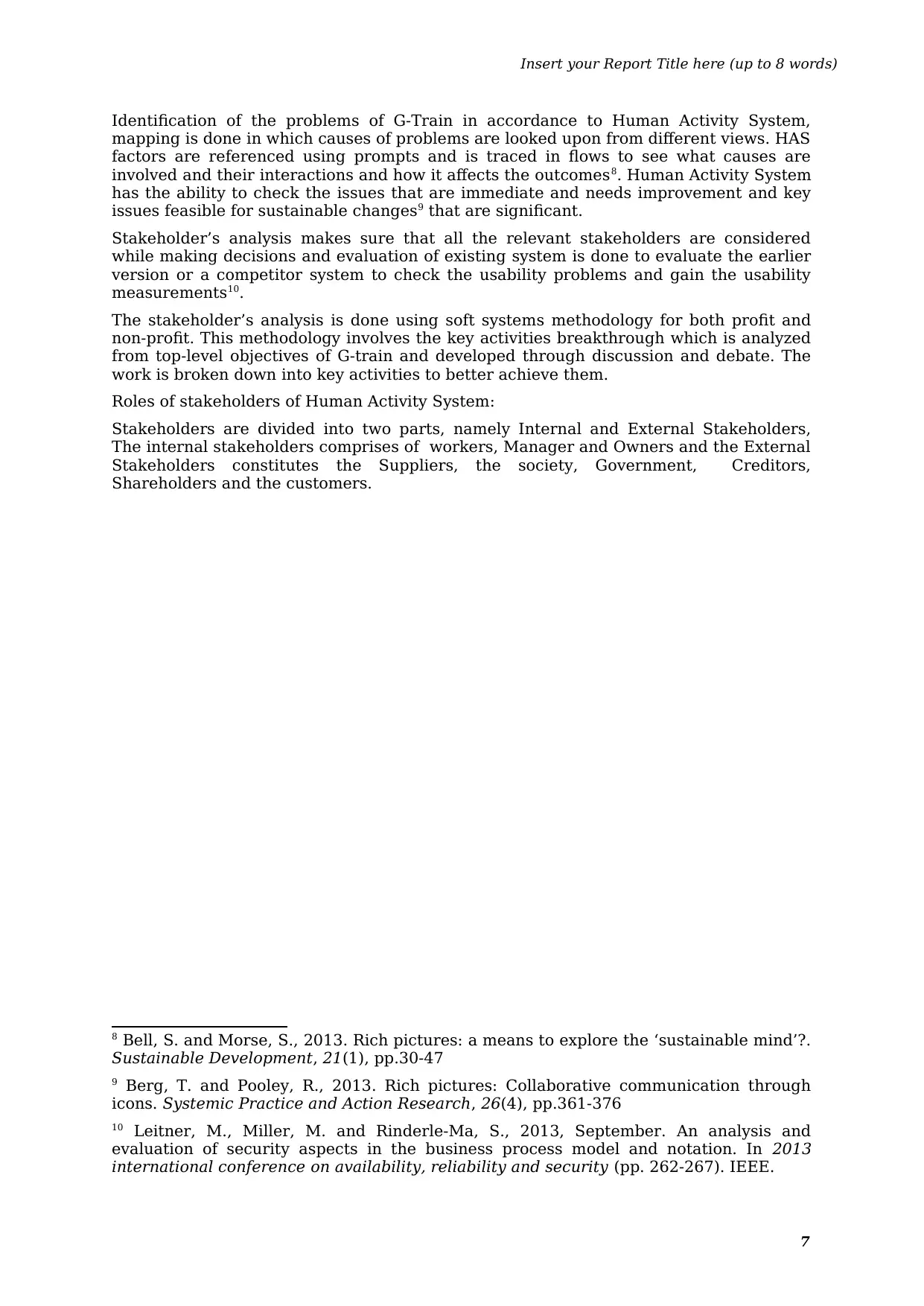
Insert your Report Title here (up to 8 words)
Identification of the problems of G-Train in accordance to Human Activity System,
mapping is done in which causes of problems are looked upon from different views. HAS
factors are referenced using prompts and is traced in flows to see what causes are
involved and their interactions and how it affects the outcomes8. Human Activity System
has the ability to check the issues that are immediate and needs improvement and key
issues feasible for sustainable changes9 that are significant.
Stakeholder’s analysis makes sure that all the relevant stakeholders are considered
while making decisions and evaluation of existing system is done to evaluate the earlier
version or a competitor system to check the usability problems and gain the usability
measurements10.
The stakeholder’s analysis is done using soft systems methodology for both profit and
non-profit. This methodology involves the key activities breakthrough which is analyzed
from top-level objectives of G-train and developed through discussion and debate. The
work is broken down into key activities to better achieve them.
Roles of stakeholders of Human Activity System:
Stakeholders are divided into two parts, namely Internal and External Stakeholders,
The internal stakeholders comprises of workers, Manager and Owners and the External
Stakeholders constitutes the Suppliers, the society, Government, Creditors,
Shareholders and the customers.
8 Bell, S. and Morse, S., 2013. Rich pictures: a means to explore the ‘sustainable mind’?.
Sustainable Development, 21(1), pp.30-47
9 Berg, T. and Pooley, R., 2013. Rich pictures: Collaborative communication through
icons. Systemic Practice and Action Research, 26(4), pp.361-376
10 Leitner, M., Miller, M. and Rinderle-Ma, S., 2013, September. An analysis and
evaluation of security aspects in the business process model and notation. In 2013
international conference on availability, reliability and security (pp. 262-267). IEEE.
7
Identification of the problems of G-Train in accordance to Human Activity System,
mapping is done in which causes of problems are looked upon from different views. HAS
factors are referenced using prompts and is traced in flows to see what causes are
involved and their interactions and how it affects the outcomes8. Human Activity System
has the ability to check the issues that are immediate and needs improvement and key
issues feasible for sustainable changes9 that are significant.
Stakeholder’s analysis makes sure that all the relevant stakeholders are considered
while making decisions and evaluation of existing system is done to evaluate the earlier
version or a competitor system to check the usability problems and gain the usability
measurements10.
The stakeholder’s analysis is done using soft systems methodology for both profit and
non-profit. This methodology involves the key activities breakthrough which is analyzed
from top-level objectives of G-train and developed through discussion and debate. The
work is broken down into key activities to better achieve them.
Roles of stakeholders of Human Activity System:
Stakeholders are divided into two parts, namely Internal and External Stakeholders,
The internal stakeholders comprises of workers, Manager and Owners and the External
Stakeholders constitutes the Suppliers, the society, Government, Creditors,
Shareholders and the customers.
8 Bell, S. and Morse, S., 2013. Rich pictures: a means to explore the ‘sustainable mind’?.
Sustainable Development, 21(1), pp.30-47
9 Berg, T. and Pooley, R., 2013. Rich pictures: Collaborative communication through
icons. Systemic Practice and Action Research, 26(4), pp.361-376
10 Leitner, M., Miller, M. and Rinderle-Ma, S., 2013, September. An analysis and
evaluation of security aspects in the business process model and notation. In 2013
international conference on availability, reliability and security (pp. 262-267). IEEE.
7
Paraphrase This Document
Need a fresh take? Get an instant paraphrase of this document with our AI Paraphraser
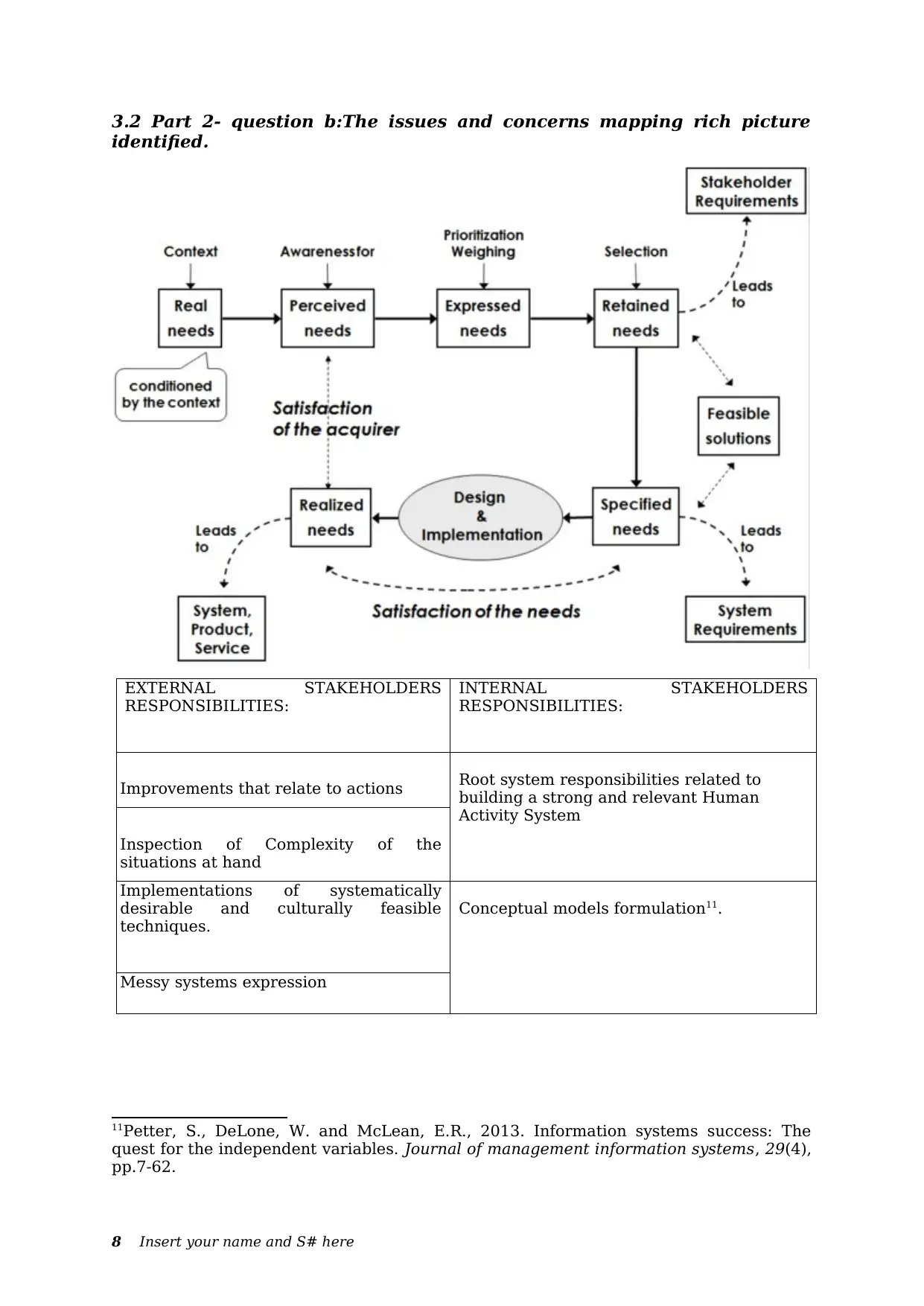
3.2 Part 2- question b:The issues and concerns mapping rich picture
identified.
EXTERNAL STAKEHOLDERS
RESPONSIBILITIES:
INTERNAL STAKEHOLDERS
RESPONSIBILITIES:
Improvements that relate to actions Root system responsibilities related to
building a strong and relevant Human
Activity System
Inspection of Complexity of the
situations at hand
Implementations of systematically
desirable and culturally feasible
techniques.
Conceptual models formulation11.
Messy systems expression
11Petter, S., DeLone, W. and McLean, E.R., 2013. Information systems success: The
quest for the independent variables. Journal of management information systems, 29(4),
pp.7-62.
8 Insert your name and S# here
identified.
EXTERNAL STAKEHOLDERS
RESPONSIBILITIES:
INTERNAL STAKEHOLDERS
RESPONSIBILITIES:
Improvements that relate to actions Root system responsibilities related to
building a strong and relevant Human
Activity System
Inspection of Complexity of the
situations at hand
Implementations of systematically
desirable and culturally feasible
techniques.
Conceptual models formulation11.
Messy systems expression
11Petter, S., DeLone, W. and McLean, E.R., 2013. Information systems success: The
quest for the independent variables. Journal of management information systems, 29(4),
pp.7-62.
8 Insert your name and S# here
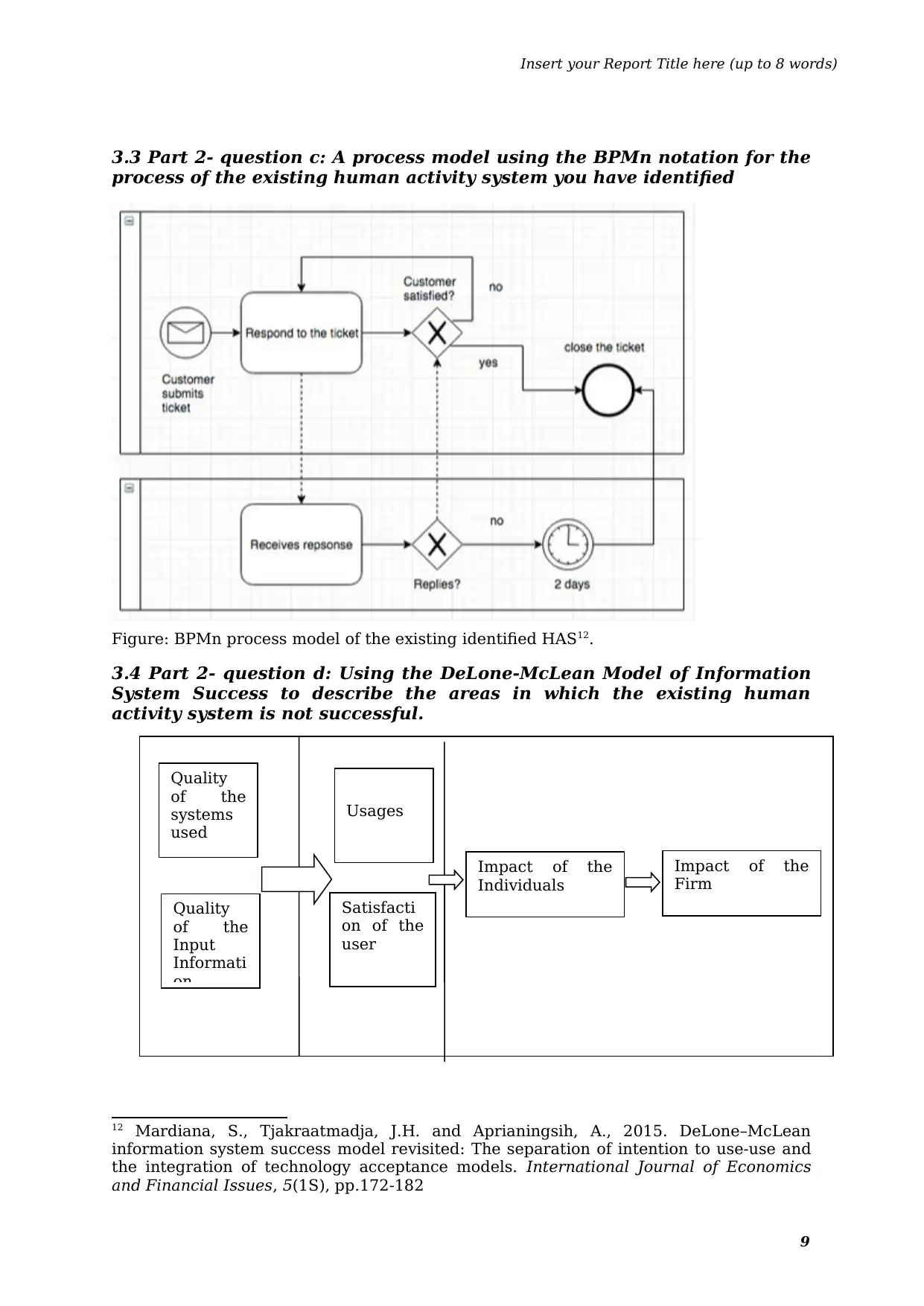
Insert your Report Title here (up to 8 words)
3.3 Part 2- question c: A process model using the BPMn notation for the
process of the existing human activity system you have identified
Figure: BPMn process model of the existing identified HAS12.
3.4 Part 2- question d: Using the DeLone-McLean Model of Information
System Success to describe the areas in which the existing human
activity system is not successful.
12 Mardiana, S., Tjakraatmadja, J.H. and Aprianingsih, A., 2015. DeLone–McLean
information system success model revisited: The separation of intention to use-use and
the integration of technology acceptance models. International Journal of Economics
and Financial Issues, 5(1S), pp.172-182
9
Quality
of the
systems
used
Quality
of the
Input
Informati
on
Usages
Satisfacti
on of the
user
Impact of the
Individuals
Impact of the
Firm
3.3 Part 2- question c: A process model using the BPMn notation for the
process of the existing human activity system you have identified
Figure: BPMn process model of the existing identified HAS12.
3.4 Part 2- question d: Using the DeLone-McLean Model of Information
System Success to describe the areas in which the existing human
activity system is not successful.
12 Mardiana, S., Tjakraatmadja, J.H. and Aprianingsih, A., 2015. DeLone–McLean
information system success model revisited: The separation of intention to use-use and
the integration of technology acceptance models. International Journal of Economics
and Financial Issues, 5(1S), pp.172-182
9
Quality
of the
systems
used
Quality
of the
Input
Informati
on
Usages
Satisfacti
on of the
user
Impact of the
Individuals
Impact of the
Firm
⊘ This is a preview!⊘
Do you want full access?
Subscribe today to unlock all pages.

Trusted by 1+ million students worldwide
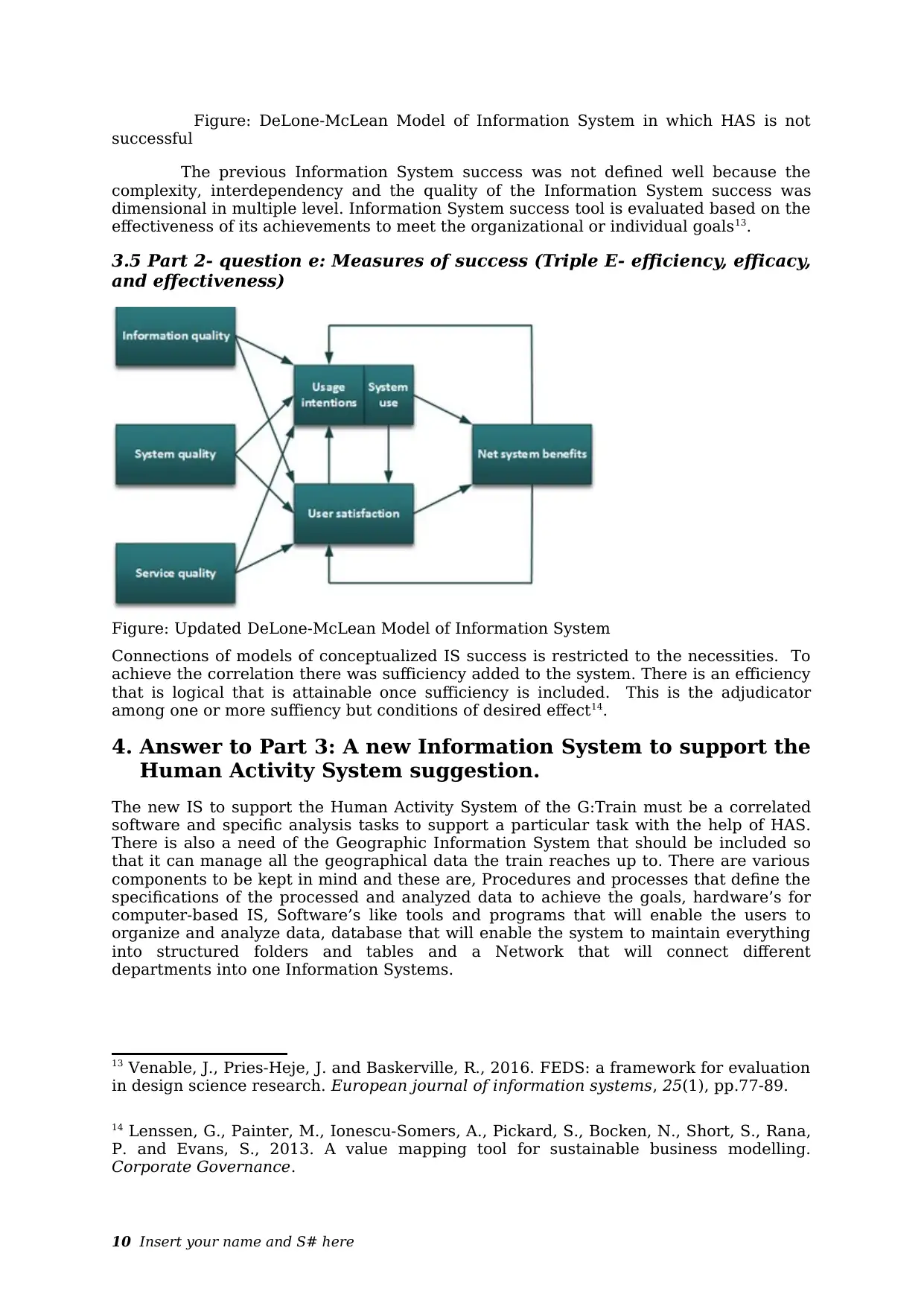
Figure: DeLone-McLean Model of Information System in which HAS is not
successful
The previous Information System success was not defined well because the
complexity, interdependency and the quality of the Information System success was
dimensional in multiple level. Information System success tool is evaluated based on the
effectiveness of its achievements to meet the organizational or individual goals13.
3.5 Part 2- question e: Measures of success (Triple E- efficiency, efficacy,
and effectiveness)
Figure: Updated DeLone-McLean Model of Information System
Connections of models of conceptualized IS success is restricted to the necessities. To
achieve the correlation there was sufficiency added to the system. There is an efficiency
that is logical that is attainable once sufficiency is included. This is the adjudicator
among one or more suffiency but conditions of desired effect14.
4. Answer to Part 3: A new Information System to support the
Human Activity System suggestion.
The new IS to support the Human Activity System of the G:Train must be a correlated
software and specific analysis tasks to support a particular task with the help of HAS.
There is also a need of the Geographic Information System that should be included so
that it can manage all the geographical data the train reaches up to. There are various
components to be kept in mind and these are, Procedures and processes that define the
specifications of the processed and analyzed data to achieve the goals, hardware’s for
computer-based IS, Software’s like tools and programs that will enable the users to
organize and analyze data, database that will enable the system to maintain everything
into structured folders and tables and a Network that will connect different
departments into one Information Systems.
13 Venable, J., Pries-Heje, J. and Baskerville, R., 2016. FEDS: a framework for evaluation
in design science research. European journal of information systems, 25(1), pp.77-89.
14 Lenssen, G., Painter, M., Ionescu-Somers, A., Pickard, S., Bocken, N., Short, S., Rana,
P. and Evans, S., 2013. A value mapping tool for sustainable business modelling.
Corporate Governance.
10 Insert your name and S# here
successful
The previous Information System success was not defined well because the
complexity, interdependency and the quality of the Information System success was
dimensional in multiple level. Information System success tool is evaluated based on the
effectiveness of its achievements to meet the organizational or individual goals13.
3.5 Part 2- question e: Measures of success (Triple E- efficiency, efficacy,
and effectiveness)
Figure: Updated DeLone-McLean Model of Information System
Connections of models of conceptualized IS success is restricted to the necessities. To
achieve the correlation there was sufficiency added to the system. There is an efficiency
that is logical that is attainable once sufficiency is included. This is the adjudicator
among one or more suffiency but conditions of desired effect14.
4. Answer to Part 3: A new Information System to support the
Human Activity System suggestion.
The new IS to support the Human Activity System of the G:Train must be a correlated
software and specific analysis tasks to support a particular task with the help of HAS.
There is also a need of the Geographic Information System that should be included so
that it can manage all the geographical data the train reaches up to. There are various
components to be kept in mind and these are, Procedures and processes that define the
specifications of the processed and analyzed data to achieve the goals, hardware’s for
computer-based IS, Software’s like tools and programs that will enable the users to
organize and analyze data, database that will enable the system to maintain everything
into structured folders and tables and a Network that will connect different
departments into one Information Systems.
13 Venable, J., Pries-Heje, J. and Baskerville, R., 2016. FEDS: a framework for evaluation
in design science research. European journal of information systems, 25(1), pp.77-89.
14 Lenssen, G., Painter, M., Ionescu-Somers, A., Pickard, S., Bocken, N., Short, S., Rana,
P. and Evans, S., 2013. A value mapping tool for sustainable business modelling.
Corporate Governance.
10 Insert your name and S# here
Paraphrase This Document
Need a fresh take? Get an instant paraphrase of this document with our AI Paraphraser
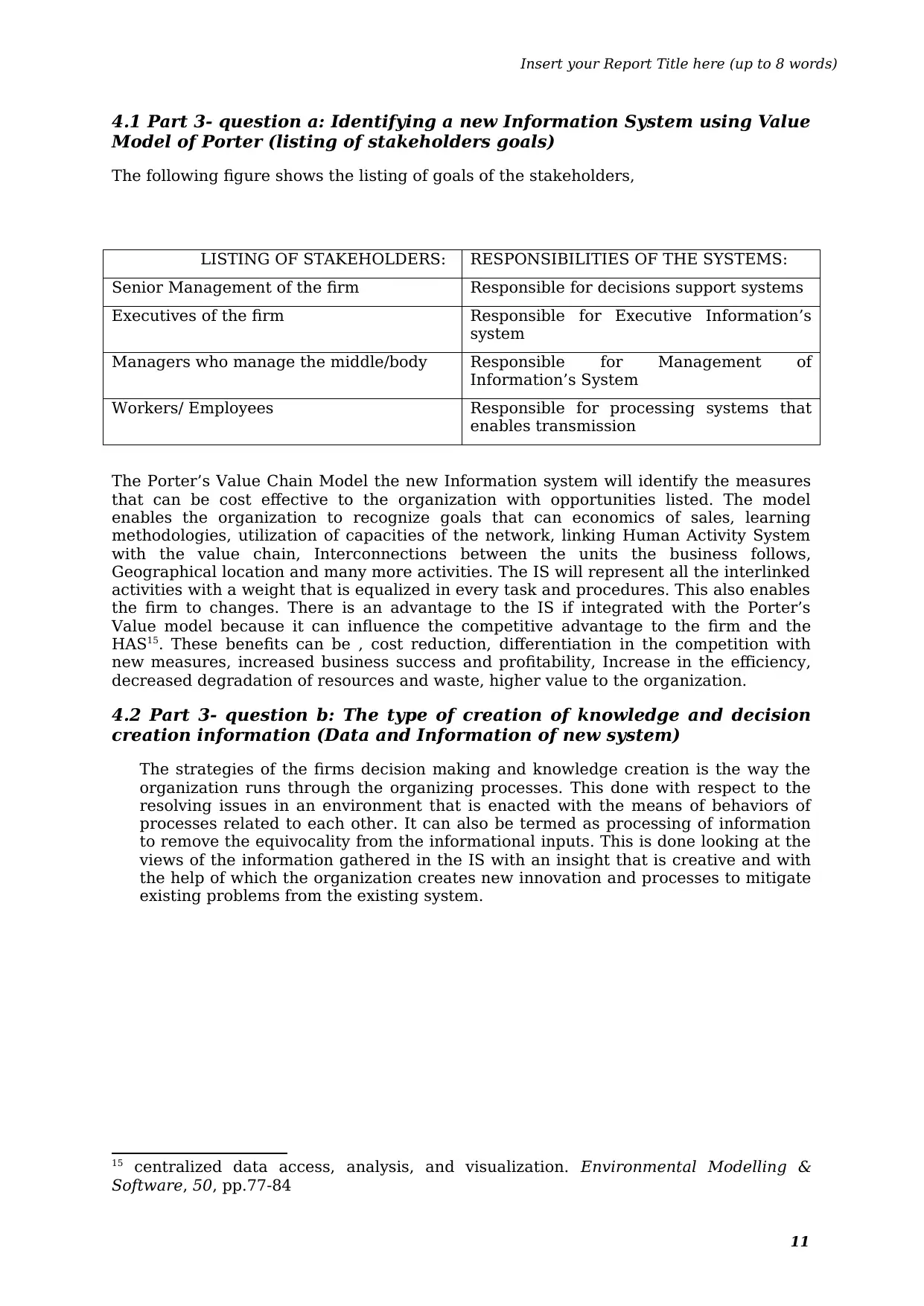
Insert your Report Title here (up to 8 words)
4.1 Part 3- question a: Identifying a new Information System using Value
Model of Porter (listing of stakeholders goals)
The following figure shows the listing of goals of the stakeholders,
LISTING OF STAKEHOLDERS: RESPONSIBILITIES OF THE SYSTEMS:
Senior Management of the firm Responsible for decisions support systems
Executives of the firm Responsible for Executive Information’s
system
Managers who manage the middle/body Responsible for Management of
Information’s System
Workers/ Employees Responsible for processing systems that
enables transmission
The Porter’s Value Chain Model the new Information system will identify the measures
that can be cost effective to the organization with opportunities listed. The model
enables the organization to recognize goals that can economics of sales, learning
methodologies, utilization of capacities of the network, linking Human Activity System
with the value chain, Interconnections between the units the business follows,
Geographical location and many more activities. The IS will represent all the interlinked
activities with a weight that is equalized in every task and procedures. This also enables
the firm to changes. There is an advantage to the IS if integrated with the Porter’s
Value model because it can influence the competitive advantage to the firm and the
HAS15. These benefits can be , cost reduction, differentiation in the competition with
new measures, increased business success and profitability, Increase in the efficiency,
decreased degradation of resources and waste, higher value to the organization.
4.2 Part 3- question b: The type of creation of knowledge and decision
creation information (Data and Information of new system)
The strategies of the firms decision making and knowledge creation is the way the
organization runs through the organizing processes. This done with respect to the
resolving issues in an environment that is enacted with the means of behaviors of
processes related to each other. It can also be termed as processing of information
to remove the equivocality from the informational inputs. This is done looking at the
views of the information gathered in the IS with an insight that is creative and with
the help of which the organization creates new innovation and processes to mitigate
existing problems from the existing system.
15 centralized data access, analysis, and visualization. Environmental Modelling &
Software, 50, pp.77-84
11
4.1 Part 3- question a: Identifying a new Information System using Value
Model of Porter (listing of stakeholders goals)
The following figure shows the listing of goals of the stakeholders,
LISTING OF STAKEHOLDERS: RESPONSIBILITIES OF THE SYSTEMS:
Senior Management of the firm Responsible for decisions support systems
Executives of the firm Responsible for Executive Information’s
system
Managers who manage the middle/body Responsible for Management of
Information’s System
Workers/ Employees Responsible for processing systems that
enables transmission
The Porter’s Value Chain Model the new Information system will identify the measures
that can be cost effective to the organization with opportunities listed. The model
enables the organization to recognize goals that can economics of sales, learning
methodologies, utilization of capacities of the network, linking Human Activity System
with the value chain, Interconnections between the units the business follows,
Geographical location and many more activities. The IS will represent all the interlinked
activities with a weight that is equalized in every task and procedures. This also enables
the firm to changes. There is an advantage to the IS if integrated with the Porter’s
Value model because it can influence the competitive advantage to the firm and the
HAS15. These benefits can be , cost reduction, differentiation in the competition with
new measures, increased business success and profitability, Increase in the efficiency,
decreased degradation of resources and waste, higher value to the organization.
4.2 Part 3- question b: The type of creation of knowledge and decision
creation information (Data and Information of new system)
The strategies of the firms decision making and knowledge creation is the way the
organization runs through the organizing processes. This done with respect to the
resolving issues in an environment that is enacted with the means of behaviors of
processes related to each other. It can also be termed as processing of information
to remove the equivocality from the informational inputs. This is done looking at the
views of the information gathered in the IS with an insight that is creative and with
the help of which the organization creates new innovation and processes to mitigate
existing problems from the existing system.
15 centralized data access, analysis, and visualization. Environmental Modelling &
Software, 50, pp.77-84
11
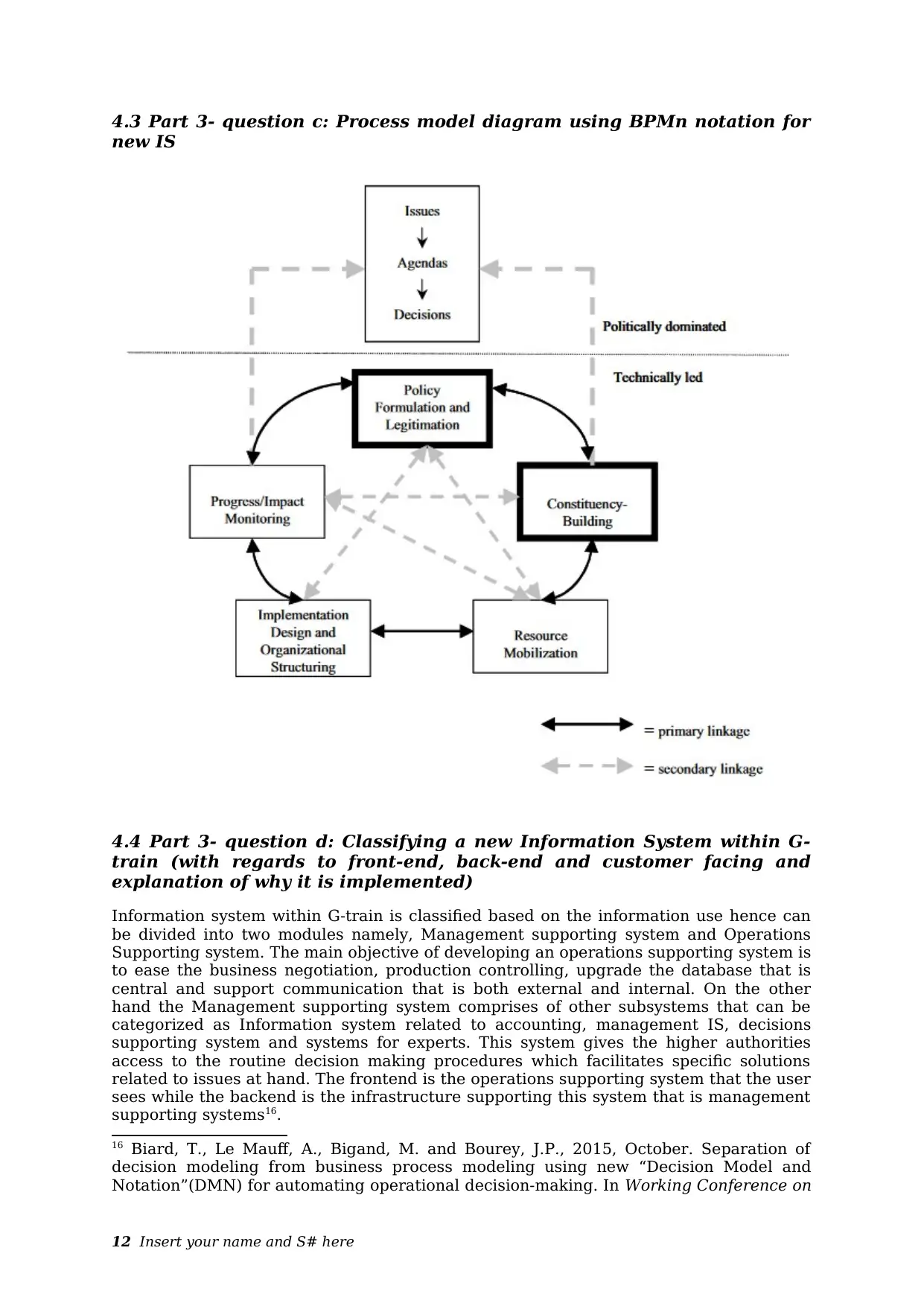
4.3 Part 3- question c: Process model diagram using BPMn notation for
new IS
4.4 Part 3- question d: Classifying a new Information System within G-
train (with regards to front-end, back-end and customer facing and
explanation of why it is implemented)
Information system within G-train is classified based on the information use hence can
be divided into two modules namely, Management supporting system and Operations
Supporting system. The main objective of developing an operations supporting system is
to ease the business negotiation, production controlling, upgrade the database that is
central and support communication that is both external and internal. On the other
hand the Management supporting system comprises of other subsystems that can be
categorized as Information system related to accounting, management IS, decisions
supporting system and systems for experts. This system gives the higher authorities
access to the routine decision making procedures which facilitates specific solutions
related to issues at hand. The frontend is the operations supporting system that the user
sees while the backend is the infrastructure supporting this system that is management
supporting systems16.
16 Biard, T., Le Mauff, A., Bigand, M. and Bourey, J.P., 2015, October. Separation of
decision modeling from business process modeling using new “Decision Model and
Notation”(DMN) for automating operational decision-making. In Working Conference on
12 Insert your name and S# here
new IS
4.4 Part 3- question d: Classifying a new Information System within G-
train (with regards to front-end, back-end and customer facing and
explanation of why it is implemented)
Information system within G-train is classified based on the information use hence can
be divided into two modules namely, Management supporting system and Operations
Supporting system. The main objective of developing an operations supporting system is
to ease the business negotiation, production controlling, upgrade the database that is
central and support communication that is both external and internal. On the other
hand the Management supporting system comprises of other subsystems that can be
categorized as Information system related to accounting, management IS, decisions
supporting system and systems for experts. This system gives the higher authorities
access to the routine decision making procedures which facilitates specific solutions
related to issues at hand. The frontend is the operations supporting system that the user
sees while the backend is the infrastructure supporting this system that is management
supporting systems16.
16 Biard, T., Le Mauff, A., Bigand, M. and Bourey, J.P., 2015, October. Separation of
decision modeling from business process modeling using new “Decision Model and
Notation”(DMN) for automating operational decision-making. In Working Conference on
12 Insert your name and S# here
⊘ This is a preview!⊘
Do you want full access?
Subscribe today to unlock all pages.

Trusted by 1+ million students worldwide
1 out of 15
Related Documents
Your All-in-One AI-Powered Toolkit for Academic Success.
+13062052269
info@desklib.com
Available 24*7 on WhatsApp / Email
![[object Object]](/_next/static/media/star-bottom.7253800d.svg)
Unlock your academic potential
Copyright © 2020–2025 A2Z Services. All Rights Reserved. Developed and managed by ZUCOL.





